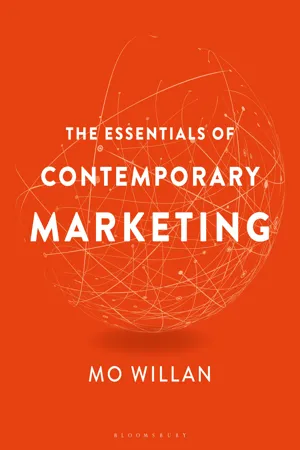
The Essentials of Contemporary Marketing
Mo Willan
- 272 páginas
- English
- ePUB (apto para móviles)
- Disponible en iOS y Android
The Essentials of Contemporary Marketing
Mo Willan
Información del libro
An essential guide to contemporary marketing that demonstrates, via case studies, the move towards marketing techniques that better reflect consumer needs. As the effectiveness of traditional marketing techniques continues to diminish, contemporary marketing increasingly becomes the most reliable method of expanding outreach and reflecting the needs of the modern consumer. When implemented, these contemporary strategies offer the greatest support for their client base, with a product range that adapts to the desires of the target market. The channels used to underpin these strategies are also radically different from traditional methods – placing emphasis upon platforms such as social media. Designed for both undergraduate and postgraduate students, as well as those in executive education and general business, The Essentials of Contemporary Marketing covers a wide range of themes, including: - Consumer behaviour
- The latest marketing research
- Services marketing
- Brand management
- Global marketing, and
- Ethics in marketing. Each chapter includes case studies to illustrate and contextualise the topics covered, featuring companies as diverse as Amazon, McLaren, Unilever, UBS and Virgin Money. In alignment with its subject matter, The Essentials of Contemporary Marketing prioritises practicality over theory-based content - providing a comprehensive and contextualised insight into how marketing is developing in the 21st century.
Preguntas frecuentes
Información
The management of the organization should consistently seek to understand what customers want and then develop the right products and services to meet and satisfy those wants. This involves engaging in continuous market research in order first to find out and determine as much as possible what exactly the wants of customers are and then to put in place the right strategies and tactics to address and satisfy such customer wants. Amazon has been very successful in this regard by developing products and services that are affordable, easy accessible online and delivered to customers quickly at their doorsteps.
The needs and wants of customers are never the same all the time. In fact, customer wants change all the time. Therefore, the ability of the firm’s management to project the future wants of customers is paramount to marketing success. Failing to foresee, capture and address consumers’ ever-changing wants will make the firm’s products redundant. Blockbuster Video is a classic example of failing to project that consumers were migrating towards digital platforms for watching films as opposed to borrowing video tapes!
This can also involve creating needs for customers. Indeed, many firms today tend to develop products and then convince consumers to buy even though their customers had never thought before that they needed such products.
This aspect of the marketing definition builds on and is the culmination of the first two components. Customer satisfaction implies that the firms produce the right products, at the right price, in the right place with the right promotional messages. It also entails that the service involved in delivering the product is fast, easy to understand and convenient for customers, and that the environment in which the product is delivered or served is comfortable, conducive and welcoming. Customer satisfaction is the bedrock of effective marketing and can yield two possible outcomes:
In recent years, the Internet has transformed the way organizations provide their products and services and how consumers interact with brands. Advances in technological developments, globalization, consumer confidence in the security of financial payment systems, and changing consumer lifestyles with an increasing emphasis on convenience have all contributed towards the growth of online interactions between organizations and their consumers. Consumers of Generation Z are digital natives, who are most comfortable interacting with organizations using digital technologies and expect firms to provide such platforms, enabling them to interact at all times and wherever they are.
Growing consumer concerns for environmental issues and sustainability will continue to influence consumer behaviours, and firms must factor this into their decision-making and strategies. The related issue of Corporate Social Responsibility (CSR) implies that firms must be good, active and responsible citizens, showing genuine concern for the well-being of both the societies in which they operate and the wider world. This issue of environmental friendliness and consideration is especially important if firms are to succeed in attracting the millennial generation, who attach a heavy emphasis to issues of environmental protection.
Marketing success very much depends on understanding consumers. This calls for firms to invest, develop and harness consumer data with the objective of better identifying and addressing consumer needs. The use of marketing metrics is important and should be based on first capturing critical consumer data and then implementing mechanisms designed to measure marketing efficiency and effectiveness.
Índice
- Cover
- Series
- Dedication
- Title
- Contents
- Overview
- CHAPTER ONE Introduction to Marketing
- CHAPTER TWO Marketing Orientations
- CHAPTER THREE The Marketing Environment
- CHAPTER FOUR Consumer Behaviour
- CASE STUDY Louis Vuitton
- CHAPTER FIVE Market Research
- CASE STUDY Eco Refill Systems
- CHAPTER SIX Market Segmentation
- CASE STUDY PlaceMe Living
- CHAPTER SEVEN The Marketing Mix
- CASE STUDY Kellogg’s Nutri-Grain
- CHAPTER EIGHT Services Marketing
- CASE STUDY JetBlue Airways
- CHAPTER NINE Brand Management
- CHAPTER TEN The Price Mix
- CHAPTER ELEVEN The Place Mix
- CHAPTER TWELVE The Promotion Mix
- CASE STUDY The American Alliance of Artists and Audiences
- CHAPTER THIRTEEN The Extended Marketing Mix
- CHAPTER FOURTEEN Marketing Planning and Strategy
- CHAPTER FIFTEEN International Marketing
- CASE STUDY Revolut
- Bibliography
- Index
- Copyright